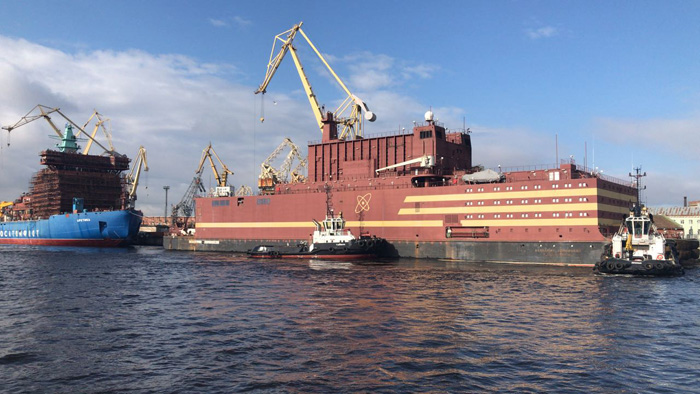 Source: Rosatom
Source: RosatomOn the atomic floating energy block "Akademik Lomonosov" on Geektimes they wrote only once a
couple of years ago . Then the builders just started the final stage of the construction of this system. Now all the engineering work has been completed, the business for the small is to deliver the hands of thousands of people to the place where the unit will work for many years. The floating energy block (FB) left the territory of the Baltiysky Zavod in St. Petersburg a couple of days ago, now it is on its way to the place of its permanent home - Chukotka.
"Swim" floating nuclear power plant is divided into two phases. The first is a trip from St. Petersburg to Murmansk. The second is from Murmansk to Pevek. Now there is neither nuclear fuel nor the main team on board the station, which will ensure the safety of the safety of the system from the beginning of the commissioning of the system. “At the first stage, a safety stage without nuclear fuel on board will be towed from the territory of the Baltic plant to the berth of FSUE Atomflot in Murmansk. Further, at the second stage - approximately in the summer of 2019 - he, with already loaded nuclear fuel and crew on board, will be delivered from Murmansk to the Pevek sea port, ”
said Dmitry Alekseenko, Deputy Head of the Directorate for the Construction and Operation of FNPP.
Previously, experts had doubts that the facility would be ready on time, but over the past few months, engineers were able to significantly increase the speed of work. This allowed to complete all the work on time. The task of the next stage is to prepare the facility for taking on nuclear fuel. Of course, this task is not at all simple, it is necessary to ensure both the safety of people and the safety of the fuel itself, coupled with the uninterrupted operation of the station itself.
Transportation is engaged in FBU "Marine rescue service Rosmorrechflot." Experts believe that in the absence of problems, including adverse weather conditions, the speed of the caravan (PEB does not travel alone) will be approximately 3.5-4.5 knots. Not much, but for a ship of this size it is quite enough.
In Pevek, where the floating nuclear thermal power plant will be located, preparatory work has been going on all this time. They are still active, because by the time the system arrives, it is necessary to create a pier, a complex of administrative and technical buildings, hydraulic structures and a coastal site. All this will ensure the safe parking of the power unit and the acceptance of the energy bridge from it in the place where the electric communications and power supply to the coast will take place.

In the autumn of this year, a team of specialists will load nuclear fuel into the reactor and launch it. The safety and security policy will then be delivered via the Northern Sea Route to the place of its permanent work, after which it will be connected to the coastal infrastructure in Pevek. After the floating NPP is commissioned and put into operation, it will be able to replace the Bilibino nuclear power plant and the Chaunskaya CHPP. They have long been technologically obsolete. By the way, if everything goes according to plan, then Akademik Lomonosov will become the northernmost nuclear power plant in the world. He himself is a transportable power unit of low power; this is a new class of energy sources based on Russian nuclear shipbuilding technologies.
In the conditions of the region where the floating NPP will be located, it is difficult to create stationary systems of this type. Technologically and logistically easier to deliver to the place the necessary object, built in another region.
As for the technical characteristics, the station is equipped with two KLT-40C reactor units, they are capable of generating up to 70 MW of electricity and 50 Gcal / h of thermal energy in the nominal operating mode. This is quite enough to provide energy to the city with a population of 100 thousand people.
The unit was designed specifically for work in the conditions of the Far North and the Far East, and its main task is to provide power to remote industrial enterprises, port cities, gas and oil platforms located in the open sea. Floating plant designed with a large margin of safety. It more than covers all possible threats, including tsunamis and other natural disasters. The current operating mode and all processes on the floating power unit meet the requirements of the International Atomic Energy Agency (IAEA).